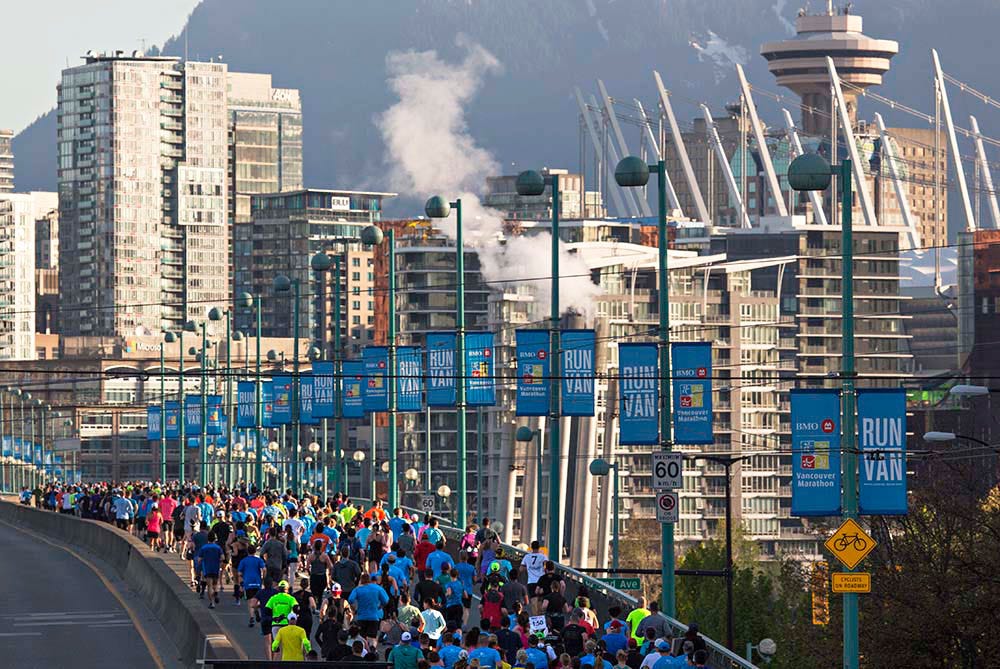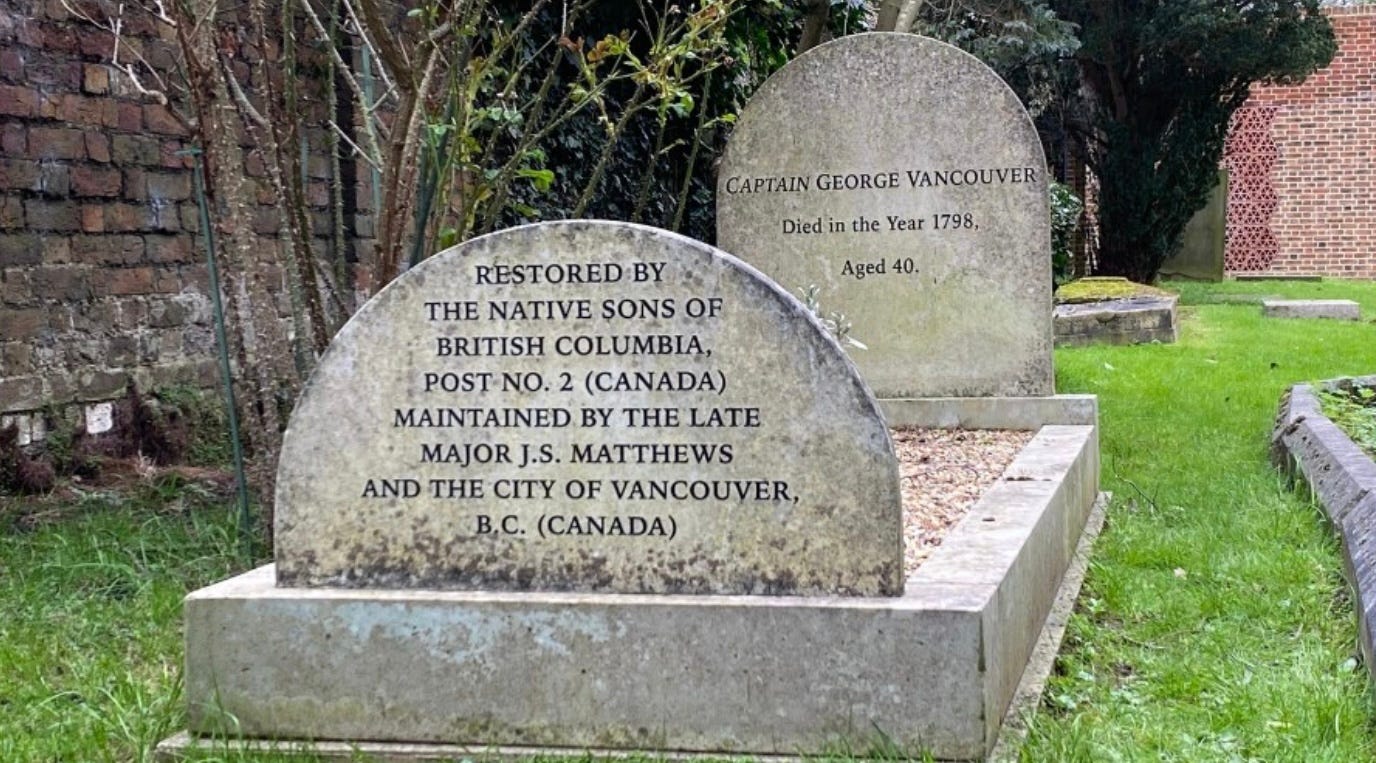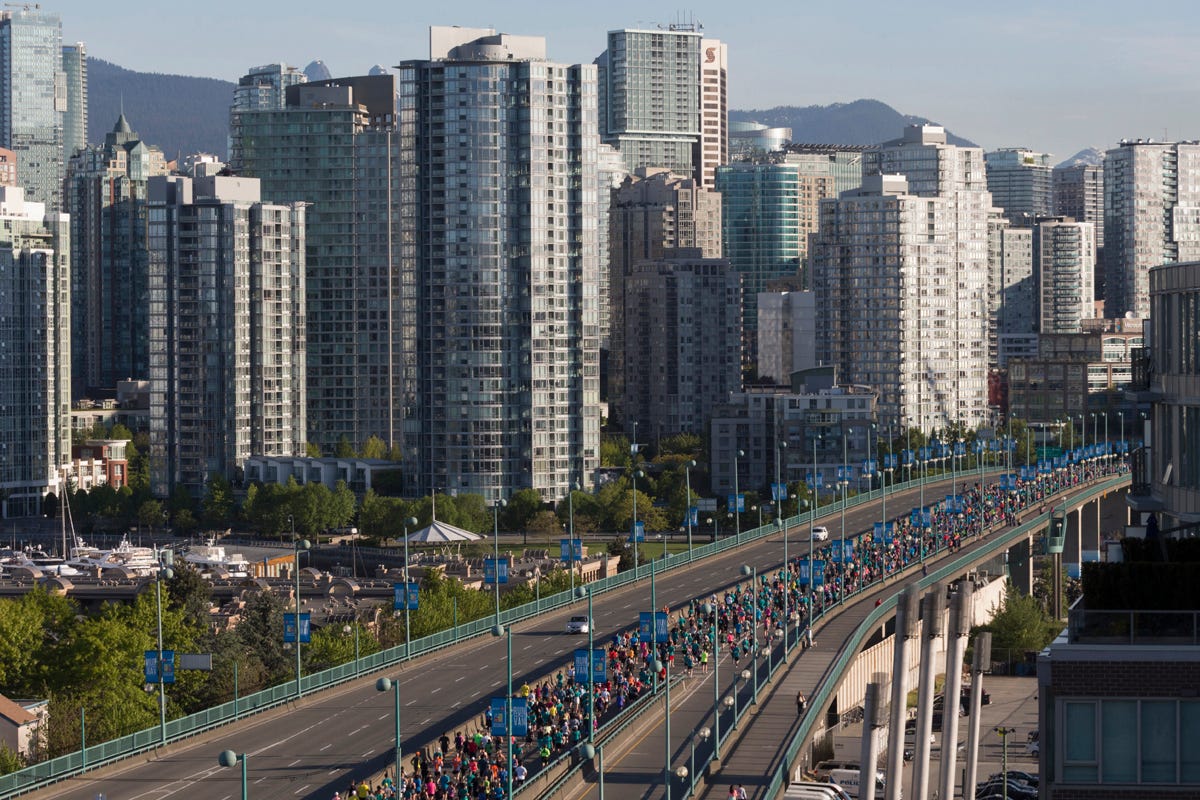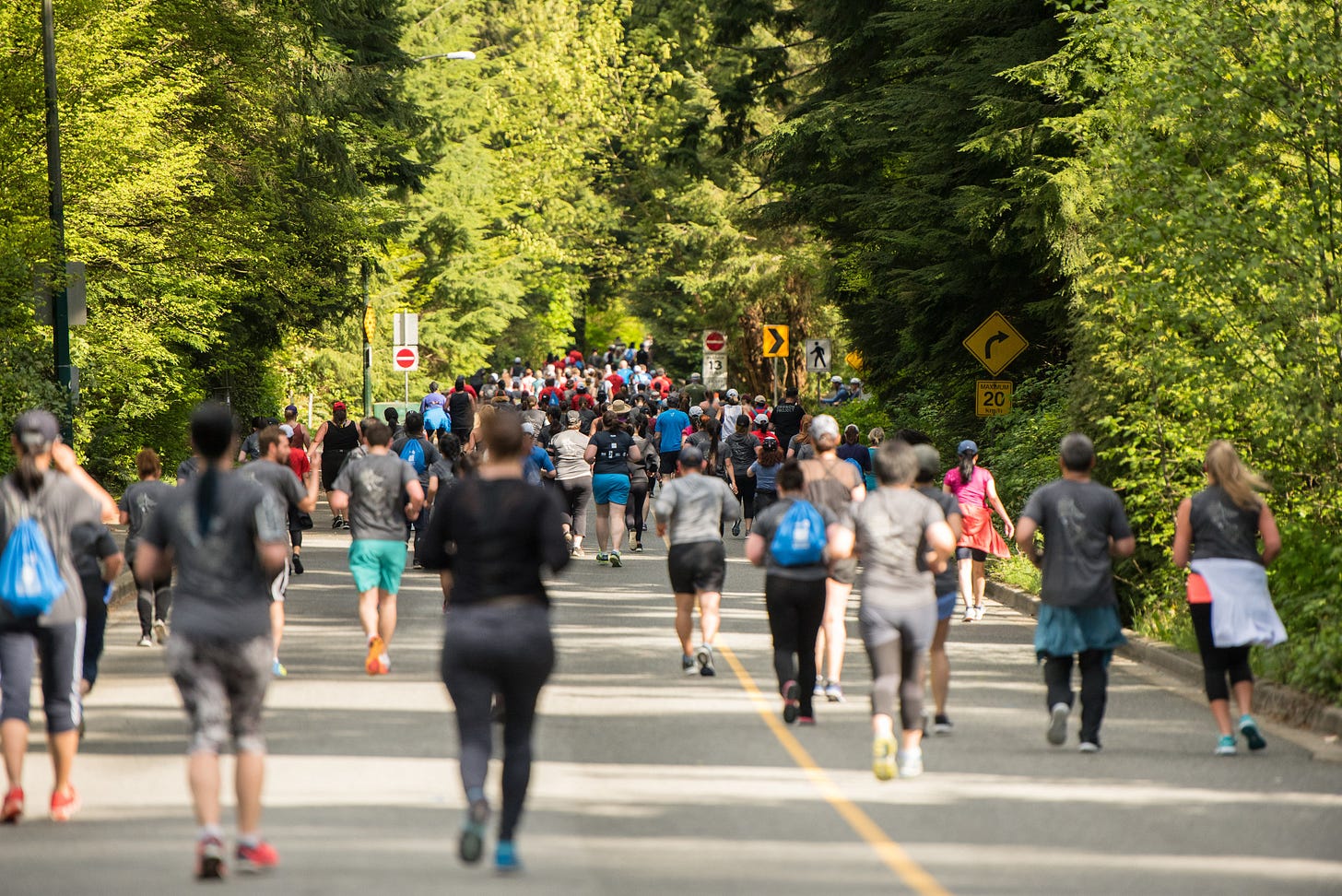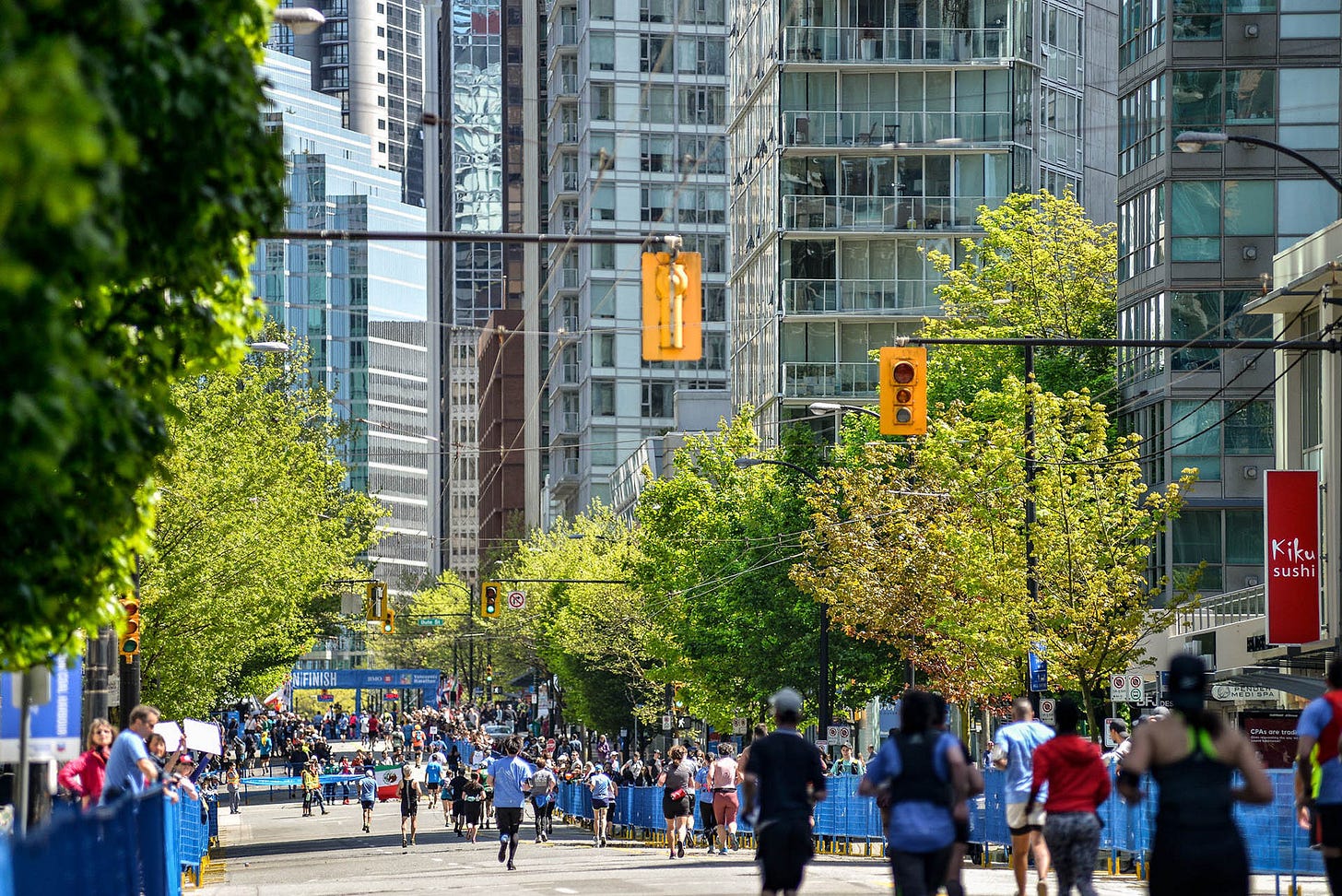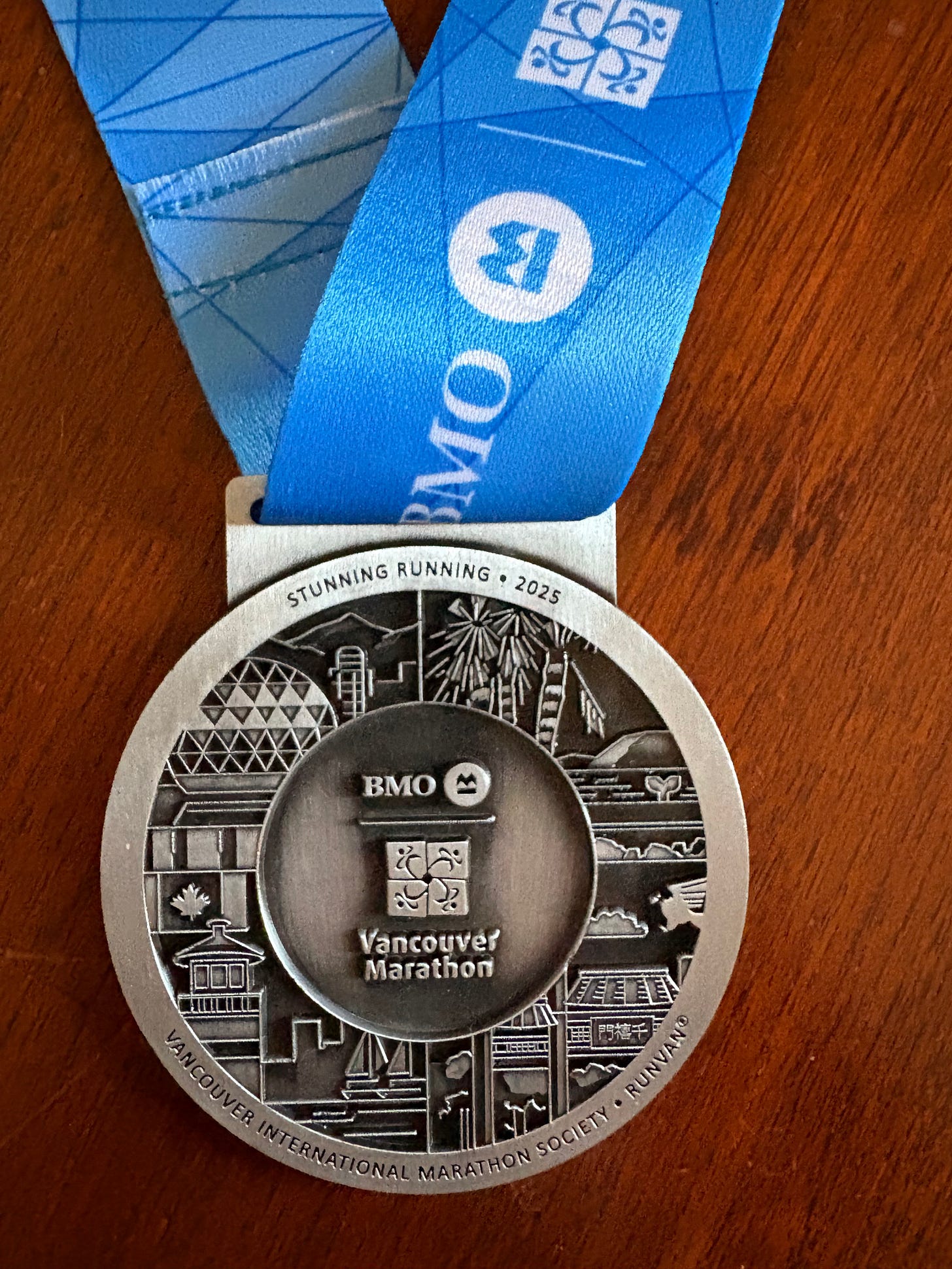BMO Vancouver Half Marathon race review
A world-class race with a stunning course. Plus: My Vancouver connection; five things to like about the city; and a capsule hotel preview.
The BMO Vancouver Marathon takes place every year on the first Sunday of May. “BMO” is short for “Bank of Montreal,” the lead sponsor. I ran the half this year. Here’s a brief report with a few digressions.
Race overview
The BMO Vancouver Marathon consists of two main events: a full marathon and a half. There’s also an 8K (actually an 8.125K, the organizers point out) — about 5 miles — an unusual distance.
The overall event is one of the biggest of its type on the North American West Coast. It’s often a bit tricky to get a firm handle on actual numbers in a race because organizers tend to emphasize the number of registered entrants, whereas the number of actual runners is always significantly lower. And results pages don’t always make it easy to glean actuals. Here, the headline number for the event was 25,000 overall, but the actual numbers appear to be a bit under 10,500 for the half, just under 7,000 for the full, and around 2,000 for the 8K — so a little under 20,000 in total. Still, that makes it a very large event by any standards.
The full marathon starts and ends in the same place as the half, but unusually, goes out an hour and a half later. At least, it did in 2025. Normally, when half and full marathons have staggered starts, the full goes out earlier, as they have longer to run. But, as a half runner, I wasn’t complaining — I like early starts to help avoid rising temperatures.
The BMO Vancouver race is comparable to other major North American West Coast events of its type, notably San Francisco, San Diego Rock-’n’-Roll, and Surf City (all in California). I’ve run all three of those multiple times. And I would say Vancouver is probably the best in its West Coast class. I base that on the course, the logistical ease of taking part, and the overall organization and vibe. More on all of that shortly.
Five things to like about Vancouver
Despite living on the Pacific coast of North America for 32 years, I’d only visited Vancouver once before. That was a trip to celebrate my 60th birthday. Then, my wife and I took the Amtrak sleeper train from Santa Barbara — our hometown — to Seattle and, after a night in that city, a regional train from there to Vancouver. That’s a great way to travel to the Pacific Northwest. The train cuts cleanly through landscapes in ways that roads — which spawn their own constant clutter — seldom do.
On this trip, however, I flew, non-revving from Santa Barbara — but also via Seattle. The flight from Seattle takes under an hour. It’s the sort of short flight where the aircraft doesn’t climb to its normal cruising altitude and there’s no time for service (a pity, as I got First Class on the return segment). But despite the short distance, I was reminded how different a place Vancouver is from any large city on the U.S. West Coast. And, candidly, how much nicer it is, too, with distinctly less urban blight and much more life in the center. Here are five things I like about Vancouver and the country of which it is part:
Public transport that works, is squeaky clean, and people want to take.
A safe, vibrant city center where people live.
Stylish urban architecture at different levels of the real estate market.
Cosmopolitan, in terms of it being a modern-day cultural mix of North America, Asia, and the UK.
Located in a country that’s run by a technocrat and with a universal healthcare system that seems generally to work.
My Vancouver connection
Although it took me 60 years to get to Vancouver for the first time, I’ve long had an obscure connection. Or maybe not so much obscure as tenuous, as the connection is to Captain George Vancouver, no less, after whom the city is named. He was the British explorer who charted the northwestern Pacific Coast regions of the American continent, including the coasts of what became the Canadian province of British Columbia.
Captain Vancouver, who died in 1798, is buried in the same small graveyard in Petersham, a corner of southwest London, where my father was buried in 1961 and my mother’s ashes were put to rest roughly 60 years later. Their plot is a stone’s throw from Vancouver’s. Vancouver was only 40 when he died, about five years younger than my father was when they became close neighbors.
The cemetery is located in what must be the most bucolic part of London. Petersham — part of the London Borough of Richmond-upon-Thames and abutting the south shore of the river — is the only part of London where cattle still graze. With parkland and conservationist planning preventing much development, parts of Petersham seem little changed from 150+ years ago. Except for the fact that it’s close to the flight path for traffic landing to the west on a five-mile final to Heathrow.
The cemetery is a couple of minutes’ walk from an entrance to Richmond Park, the largest urban park in Europe, which is one of the best places to run anywhere in London. The whole area is overlooked by overseas visitors under the mistaken impression that the best of London is only to be found in the center.
I grew up in Petersham, and when I’m asked where I’d like my own ashes to end up, I haven’t come up with a better idea than there, close to Captain Vancouver. It’s a much more charming cemetery than the rather manicured one not far from us in Santa Barbara. Assuming I die close to home, the transportation of the urn containing my ashes would be my last of several hundred transatlantic flights. It would have to be in Business Class, of course. I wouldn’t want my last flight to be in the overhead bin above row 48.
An outstanding half marathon course
But I digress. The BMO Vancouver event is an urban race with a truly outstanding and varied course. Course-wise, I put it alongside epic races I’ve run in New York City, London, Berlin, Sydney, and Tokyo. But it’s easier to snag a spot. Although it does sell out, I was still able to get a place several months before race day.
That said, I’ve noticed over the past couple of years that top races are selling out all over the world earlier and earlier. Some that used to have places a few months out are now selling out soon after registration opens. There’s always a risk if you register very early that you won’t, in the end, be able to run the race for one reason or another. Few races allow you to defer, and not many allow you to transfer your entries. But if you don’t take that risk, you’re cutting yourself off from some of the world’s best events.
Vancouver is a stunning city in any context — both because of its own urban landscape and the natural ocean and mountain landscapes visible from many parts within it — and this race gives you literally the run of the city. The course starts in Queen Elizabeth Park, to the south of downtown Vancouver, and takes you over Cambie Bridge crossing False Creek into downtown and then through various neighborhoods, including Chinatown, Yaletown, and Stanley Park. Along the way, you get memorable views of the city, the Pacific Ocean, snow-capped mountains, and spring blossoms. The race ends right in the heart of the Central Business District. Adding to the variety is the fact that it’s a point-to-point course throughout. You never run back on a segment you’ve already done in the other direction.
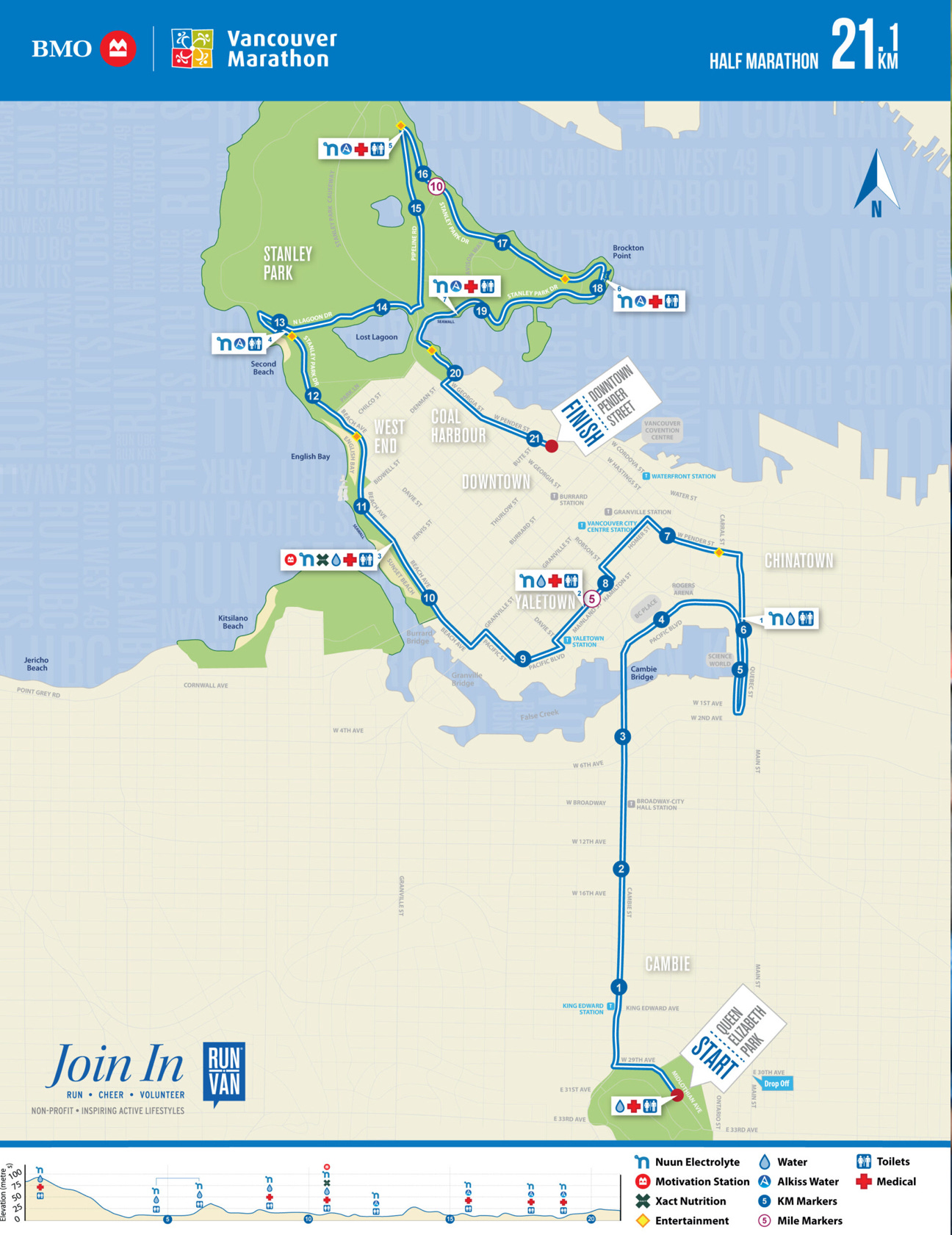
It’s a net downhill course by a fair margin. But most of the downhill is in the first few miles. After that, it’s more or less elevation-neutral overall, but with some gentle ups and downs along the way. I’d rate it as a moderate-to-easy course as half marathons go.
Race logistics
Packet pickup was at the Convention Center, not too far from where the race ends, on the Friday and Saturday before the Sunday event. This was one of the largest race expos I’ve come across since the pandemic. Ever since then, expos just haven’t been what they were in terms of the number of exhibitors and the overall buzz. But Vancouver’s was pure 2019. There were some big names in running present — such as Brooks and Garmin — but also some exhibitors you wouldn’t necessarily expect, such as Turkish Airlines and Yorkshire Tea.
One of the logistical issues when traveling to run point-to-point races is whether to stay positioned close to the start or the finish. It’s a topic about which I can debate — indeed, agonize — at length. On the whole, I’m more of a “start” person. But the Vancouver race makes the decision easier as there really aren’t any hotel choices within walking distance of the start, which is in a largely residential area halfway between downtown and the airport.
However, the good news is that if you stay in the center — close to where the race ends — it’s really quick and easy to take Vancouver’s excellent public transport system on race morning. From downtown to King Edward Station, the stop closest to the race start, takes less than 15 minutes by metro on the Canada Line. And trains were already in full swing in ample time for the 7 a.m. start for the half. There were lots of runners on the train I boarded, but not so many I was concerned about not squeezing in. When you get to the arrival station, just follow the crowds. By the way, look out for free race-morning metro tickets at the expo.
I ended up booking into the Hyatt Regency in downtown for the Saturday night. The location was ideal for the race finish and an easy walk to the expo. Vancouver can be a pricey city, and hotels for race night in the downtown area were averaging in the US$400+’s in the weeks leading up to the race. I managed to snag a late $355 rate at the Hyatt — taxes and fees included — which was more than I normally pay for race hotels but a bit of a bargain in the context. The hotel was fine, but nothing special.
The night before, I got into Vancouver at around midnight and wanted to be up soon after 6 a.m. so as to be on the right clock for the race. I hate paying for hotels for just a few hours, but discovered there was a “capsule hotel” — the type that’s common in Japan, but rare elsewhere — quite near the Vancouver airport where you can get a “sleeping pod” to tide you over for the night. It was a good experience (clean and at least as comfortable as lie-flat Business Class on a plane as well as more private). It’s called Panda Pod. I’ll save the full capsule discussion for another post, as I tried out the “real thing” in Tokyo just over a week later after taking Alaska’s inaugural Narita flight from Seattle. So I’ll merge my Vancouver capsule discussion with my post on that.

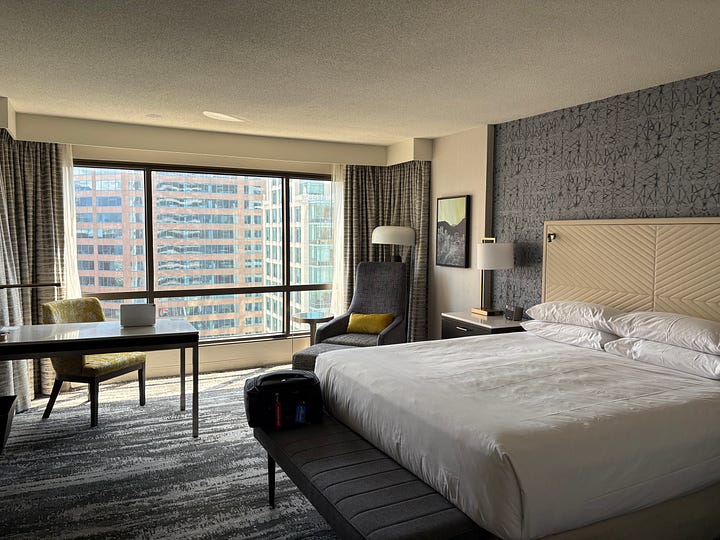
Start and finish
The race start was well organized. When I arrived about 45 minutes before the start, there were plenty of open porta-potties. Later, lines developed, but they seemed typical. Unlike at most starts, there was ample water. Unusually for a race of this size, however, there was no bag-check at the start. The only option was a bag check at the expo if you wanted to have anything waiting for you at the end. I rarely use bag checks. But this might be an irritant for some.
The race went out on time. And they moved the waves out pretty quickly. After the usual crowded quarter of a mile or so, the pack thinned out reasonably. Crowd support along the course was great. As usual, it peaked in the final stretch, but it was present throughout.
The race finish area was very crowded. That was a function of it being on a city street. There was limited space for people to fan out. So don’t plan on getting out too quickly if you’ve got a plane to catch.
[The Vancouver race I ran]
I put that subheading in brackets, hoping you won’t read this bit. Because the race I ran wasn’t nearly as pretty as the race itself. These days, I try to emphasize running a stable, controlled race, not necessarily chasing a personal record. Right now, I am just not going to finish in around two hours, as I could a couple of years or so ago, so I’m not going to stress too much about my time. Sadly, though, my race in Vancouver was neither fast nor stable. The reason was that I went down with gastric issues the night before. I’ll spare you the details.
My wife, who joined me in Vancouver that evening after coming off work at her base in Seattle, wondered whether it was a good idea for me to run. And had the organizers — upon learning of my plight — called in the pre-dawn hours and offered to postpone the event by a week, I would have gladly accepted. However, since that call did not come, I ventured out to the race, and I am glad I did. It was far from great, but it could have been worse. I finished in two hours and 26 minutes, putting me at 6,718th place out of 10,401.
These days, I don’t repeat too many races, as there are so many new ones I want to experience. But I felt my Vancouver mission was not quite complete. So I may be back there next year. However, my next half marathon stop is Melbourne (the one in Australia, not Florida). Onward and upward, etc.
Two other Vancouver races
There is another Vancouver half marathon, by the way, and that one is simply called the “Vancouver Half Marathon” — that event doesn’t also have a full. It takes place about six weeks later. It doesn’t take you through downtown, but it looks like a great race and I hope to run it in the future. Also worth noting is the Vancouver Sun Run, a 10K that’s the third-largest timed event of its distance in North America. That race takes place in April and is mostly run in downtown, where it starts and ends. Maybe I’ll run it as well, as I’d like Vancouver to become a more prominent part of my travel rotation.
BMO Vancouver half marathon conclusion
For: Large, world-class event; fantastic course. Against: Very little besides the crowded finish and, maybe, absence of race-day bag check for those who want it. Sum-up: Probably the best North America West Coast large half/full marathon event — and one of the best in the entire continent. ✈️ 🏃
If you’ve stumbled across this post, please consider subscribing to this blog using the button below. It covers the intersection of running, travel, and aviation. Subscribing costs nothing — and never will — but supports the site. You’ll get an email every month or two with new posts.
For a list of other recent posts, click here.
And please share this post with others who may be interested, using this button:

